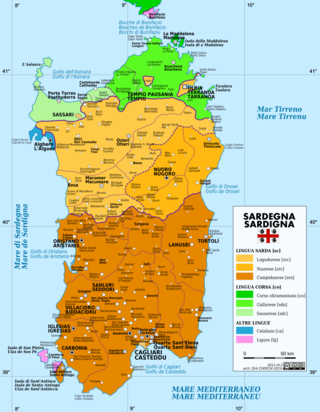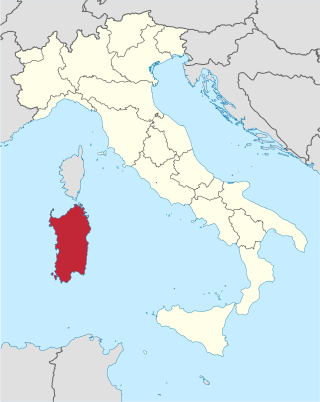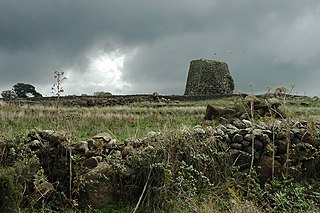
Sardinian surnames are surnames with origins from the Sardinian language or a long, identifiable tradition on the Western Mediterranean island of Sardinia.

Sardinian surnames are surnames with origins from the Sardinian language or a long, identifiable tradition on the Western Mediterranean island of Sardinia.

In Roman epigraphs from Sardinia, onomastics sometimes appear that would later come back in medieval and/or modern times. We mention for example: Torbenius Kariti (CIL, X, 7876) that reverberates in the medieval Torbenio / Torbeni / Torbini / Turbini / Dorbeni; Monioritinus (CIL, X, 7877), related to the surname Moni / Monni; Baris / Barix and the medieval Barisone / Parisone; Valeria Amoccada to today's surname Mocco; Ietoccor Torceri filius to the medieval Ithoccor and today's Stoccoro. [1]
Witnesses of this exchange carried out with good and mutual agreement: donno Trogodori Corsu de facto curator of Bonarcado, and Torbini de Piras head of the circumscription, and Goantine de Baniu cleric and Petru Marki cleric of Solarussa, and Petru d'Ardaule cleric, and Petru Contu and Goantine de Rue and Tericu Maiu and Taniel Kerssa and Petru Coco and Benzivenni and Petru Manis.
Among the most valuable sources for the study of ancient Sardinian onomastics are the condaghes, administrative registers of the Sardinian Judicates dating back to the 11th-13th centuries, as well as the Ultima Pax Sardiniae, a 1388 peace treaty between John I of Aragon and Eleanor of Arborea, in which most of today's Sardinian surnames can be found, often written with a slightly different spelling (e.g. De Thori, today Dettori).

Since the mid-16th century, thanks to the institution of the Quinque Libri, decided at the Council of Trent, [2] it is possible to reconstruct the history and evolution of Sardinian surnames generation after generation. Surnames were frequently inherited from the maternal side, from the Middle Ages up to contemporary times. [3]
Current Sardinian surnames originated in the late Middle Ages. Most of the Sardinian-specific surnames derive from the Sardinian language, denoting toponyms (e.g. Bitti, from Bitti or Onnis/Onni and Fonnesu, from Fonni [4] ), in particular of ancient villages (e.g. Kerki, a village in the curatoria of Nurra, and resulting in today's Cherchi, or Sogus, in the curatoria of Gippi, from which derive today's Sogus and Desogus [4] ) now largely disappeared (it is well known, as recorded by the historian John Day, the abandonment of hundreds of Sardinian villages during the 14th century because of the Black Death and the Sardinian-Catalan war [5] ), animal names (e.g. Porcu "pig", Piga "magpie", Cadeddu "puppy dog" etc.), plant names (e.g. Meloni "melon", Floris "flower"), color names (e.g. Biancu "white", Nieddu "black"), nicknames (e.g. Pittau "Sebastian" [6] ), sometimes indicative of a personal trait (e.g. Mannu "big") or of a filial relationship (e.g. Corbeddu, "son/daughter of Mr. Corbu" [6] ), and to a lesser extent anthroponyms (e.g. Catte, Marche "Marc" etc.) or trade names (e.g. Frau "blacksmith"); [4] some of them derive from forms related to the Paleo-Sardinian substratum and sometimes already attested as onomastic forms in Sardinian epigraphs from the Roman period.
Among the Sardinian-language surnames which trace their roots outside the island, the most relevant percentage (7% of the total [7] ) is constituted by surnames from Corsica (France), or those indicating a possible Corsican origin (e.g. Còssu, formerly written Corsu, that is "Corsican" or Còssiga, "Corsica" [8] ); these are widespread mainly, but not exclusively, in the Northern Sardinian regions of Gallura, Anglona and Sassari, where people from Corsica are recorded to have settled down and even influenced the local linguistic landscape. A considerable migratory flow coming from the other side of the Strait of Bonifacio occurred, in fact, since the Middle Ages and ended only in the first decades of the 19th century. [9]
Relatively common are also surnames originating from the Italian peninsula or indicating a possible Italian origin (e.g. Massa, ancient Di/De Massa e.g. Arsocco di Massa, [10] meaning from Massa, the Sardinian-language Pisanu or the Italian equivalent Pisano, meaning from Pisa, Pirisinu from Perugia [4] ), some of which are documented starting from the Judicates' period, and especially Ligurian and Tuscan surnames due to the political relations and trade between Sardinia and the two maritime republics of Genoa and Pisa; among the most influential in Sardinian history, the Lacon-Massa (Obertenghi), the Doria, the Visconti etc.
Quite significant is also the number of Iberian surnames, or surnames originating from the Iberian peninsula and specifically from the region of Catalonia (e.g. Aymerich, [11] Canelles, Sanjust [12] etc.). There are also cases of surnames that indicate an Iberian origin, even illustrious ones, already attested in records pertaining to the Judicates, such as Iohanne Cadalanu [13] ("John the Catalan") or Gosantine de Maiorica ("Constantine from Mallorca"), [4] or the same royal family of the Arborean Judicate, the De Serra Bas, who partly descended from the Cervera's line, Visconts of Bas; they brought a large following to Arborea, [14] including perhaps the progenitors of the Garau families, from the Catalan Guerau "Gerard". [15]
The following surnames are the twenty most widespread ones in Sardinia: overall, 10 of them are required to identify 10% of the Sardinian population, and less than 100 for one third of all the island's residents. [16]
The following surnames are the most widespread ones by Province, the most common of which is Sanna ("fang"). [17]
| Province | Surnames |
|---|---|
| Cagliari | Melis, Piras, Sanna, Serra, Meloni, Lai, Murgia, Pinna, Orrù, Loi. |
| Medio Campidano | Sanna, Piras, Melis, Murgia, Pinna, Serra, Madeddu, Atzeni, Garau, Urru. |
| Carbonia-Iglesias | Pinna, Melis, Piras, Sanna, Serra, Manca, Pintus, Diana, Floris, Lai. |
| Ogliastra | Lai, Piras, Loi, Melis, Deiana, Usai, Murru, Demurtas, Serra, Mereu. |
| Nuoro | Sanna, Piras, Manca, Carta, Porcu, Lai, Mura, Pinna, Floris, Serra. |
| Oristano | Sanna, Piras, Pinna, Manca, Mura, Carta, Serra, Meloni, Melis, Porcu. |
| Sassari | Sanna, Pinna, Piras, Manca, Mura, Sechi, Cossu, Solinas, Canu, Chessa. |
| Olbia-Tempio | Sanna, Deiana, Spano, Carta, Cossu, Addis, Pinna, Careddu, Meloni, Azara. |

Gallurese is a Romance dialect of the Italo-Dalmatian family spoken in the region of Gallura, northeastern Sardinia. Gallurese is variously described as a distinct southern dialect of Corsican or transitional language of the dialect continuum between Corsican and Sardinian. "Gallurese International Day" takes place each year in Palau (Sardinia) with the participation of orators from other areas, including Corsica.

Sardinian or Sard is a Romance language spoken by the Sardinians on the Western Mediterranean island of Sardinia.

Sardinia is the second-largest island in the Mediterranean Sea, after Sicily, and one of the twenty regions of Italy. It is located west of the Italian Peninsula, north of Tunisia and immediately south of the French island of Corsica.

Archaeological evidence of prehistoric human settlement on the island of Sardinia is present in the form of nuraghes and other prehistoric monuments, which dot the land. The recorded history of Sardinia begins with its contacts with the various people who sought to dominate western Mediterranean trade in classical antiquity: Phoenicians, Punics and Romans. Initially under the political and economic alliance with the Phoenician cities, it was partly conquered by Carthage in the late 6th century BC and then entirely by Rome after the First Punic War. The island was included for centuries in the Roman province of Sardinia and Corsica, which would be incorporated into the diocese of Italia suburbicaria in 3rd and 7th centuries.

Sassarese is an Italo-Dalmatian language and transitional variety between Sardinian and Corsican. It is regarded as a Corso–Sardinian language because of Sassari's historic ties with Tuscany and geographical proximity to Corsica. Despite the robust Sardinian influences, it still keeps its Corsican roots, which closely relate it to Gallurese; the latter is linguistically considered a Corsican dialect despite its geographical location, although this claim is a matter of controversy. It has several similarities to the Italian language, and in particular to the old Italian dialects from Tuscany.

The Judicates, in English also referred to as Sardinian Kingdoms, Sardinian Judgedoms or Judicatures, were independent states that took power in Sardinia in the Middle Ages, between the ninth and fifteenth centuries. They were sovereign states with summa potestas, each with a ruler called judge, with the powers of a king.

Barison II or Barisone II was the "Judge" of Arborea, one of the four Judicates of Sardinia, from 1146 to 1186. He was the son of Comita II and Elena de Orrubu. His reign was groundbreaking in Sardinian history. It saw the birth of Catalan influence, the escalation of the Genoese-Pisan conflict, and the first royal investiture over the entire island when Barisone was briefly recognised as King of Sardinia by the Holy Roman Emperor from 1164 to 1165.

The Giara horse is a horse breed native to the island of Sardinia. It is one of the fifteen indigenous horse "breeds of limited distribution" recognised by the AIA, the Italian breeders' association. While of small size due to the hostile environment in which it lives, and sometimes called a "pony," it is considered a true horse.

The Sardinians, or Sards, are a Romance language-speaking ethnic group native to Sardinia, from which the western Mediterranean island and autonomous region of Italy derives its name.

The Perfect Fusion was the 1847 act of the Savoyard King Charles Albert of Sardinia which abolished the administrative differences between the mainland states and the island of Sardinia within the Kingdom of Sardinia, in a fashion similar to the Nueva Planta decrees between the Crown of Castile and the realms of the Crown of Aragon between 1707 and 1716 and the Acts of Union between Great Britain and Ireland in 1800.

Paleo-Sardinian, also known as Proto-Sardinian or Nuragic, is an extinct language, or perhaps set of languages, spoken on the Mediterranean island of Sardinia by the ancient Sardinian population during the Nuragic era. Starting from the Roman conquest with the establishment of a specific province, a process of language shift took place, wherein Latin came slowly to be the only language spoken by the islanders. Paleo-Sardinian is thought to have left traces in the island's onomastics as well as toponyms, which appear to preserve grammatical suffixes, and a number of words in the modern Sardinian language.

A condaghe, from the medieval Sardinian term kondake, was a kind of administrative document used in the Sardinian judicates between the 11th and 13th centuries. They are one of the earliest witnesses for the development of the Sardinian language and are an important source for historians of medieval Sardinia.

Sardinian nationalism or also Sardism is a social, cultural and political movement in Sardinia calling for the self-determination of the Sardinian people in a context of national devolution, further autonomy in Italy, or even outright independence from the latter. It also promotes the protection of the island's environment and the preservation of its cultural heritage.

Hampsicora was a Sardo-Punic political leader and landowner of Sardinia, and the leader of the major anti-Roman revolt in the province of 215 BC.

The Marquisate of Oristano was a marquisate of Sardinia that lasted from 1410 until 1478

Sardinia's Day, also known as Sardinian people's Day, is a holiday in Sardinia commemorating the Sardinian Vespers occurring in 1794–96.

The Sardinian–Aragonese war was a late medieval conflict lasting from 1353 to 1420. The fight was over supremacy of the land and took place between the Judicate of Arborea -- allied with the Sardinian branch of the Doria family and Genoa -- and the Kingdom of Sardinia, the latter of which had been part of the Crown of Aragon since 1324.
Limba Sarda Comuna (LSC) is an orthography for the Sardinian language, created with the aim of transcribing the many variants of spoken Sardinian, with their distinctive characteristics, in the same way, and adopted experimentally in 2006 by the Autonomous Region of Sardinia for the official writing of its acts, jointly with Italian.
{{cite book}}: CS1 maint: location missing publisher (link){{cite book}}: CS1 maint: location missing publisher (link)